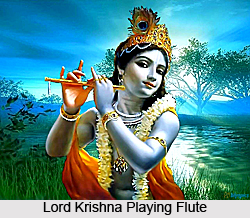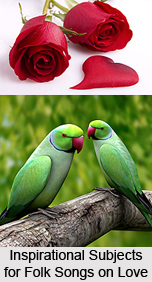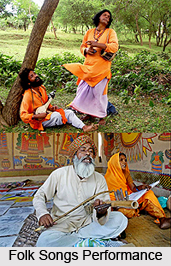 Folk songs on love are a prime category of folk music in India. Love constitutes the principal theme of folksongs of India as in the rest of the world. The folk-mind is nurtured through quiet contact with nature and the experiences bred by it. Since nature forms such a big part of the life of the people, the beloved is often compared with objects of nature. For instance, a girl in Indian folk-poetry is often compared to a young bamboo. The bamboo is tall and straight, slender, and gracefully sways in a wind. An Assamese folksong on the theme goes, thus:
Folk songs on love are a prime category of folk music in India. Love constitutes the principal theme of folksongs of India as in the rest of the world. The folk-mind is nurtured through quiet contact with nature and the experiences bred by it. Since nature forms such a big part of the life of the people, the beloved is often compared with objects of nature. For instance, a girl in Indian folk-poetry is often compared to a young bamboo. The bamboo is tall and straight, slender, and gracefully sways in a wind. An Assamese folksong on the theme goes, thus:
I looked onto the bamboo-top,
To see which one is straight,
I looked into the face of my beloved,
O, it was a full moon.
Yet other songs have different comparisons, such as, the Ho song which compares a young girl to a paddy ear. The images, more often than not, are stated on the same footing as the facts narrated. In gracefulness, the plantain tree comes next. It is an object of adoration all over India, connected as it is, with religious ritual almost everywhere. It is its gracefulness and youthful robustness that occupy the folk-mind more. A young girl is often compared to the plantain. In other places, such as Chattisgarhi folk songs, the girl is compared to a cane flower and water lily whereas the boy is compared to a black bee. The lover as a bee, more often a bumble bee, is a common image in Indian poetry. In folk-poetry, the bee is the lover. The beloved is the honey. Apart from this, a number of other references are made in love poems. The terms of endearment generally used in Indian folk-poetry are all objects from the world of vegetation: "red spinach", "honeycomb", "sweet cinnamon". Love is "eating", according to the folk-mind.
 Songs Inspired by Gold and Silver
Songs Inspired by Gold and Silver
There are tribal folksongs in which references are made to jewels; although it is not probable that the poor tribes have seen them. There are liberal references to gold and silver in Indian folk-songs; they are used mostly as symbols of value. The following Gond song is an instance:
The pans are of gold,
The scales are of silver,
Better is it for us to talk in secret,
For in the village they are saying:
That we shall one day run away,
Songs Inspired by Bird
The bird, considered as epitome of fidelity, is a common image in Indian folk-poetry. They are often employed as messengers of love, like Pigeon is a recurring theme in the classical mythologies of India. The swan finds a place of honour in Sanskrit mytho-romantic poetry. In Indian folk-poetry, it is the parrot that occupies the position of pride. The Myna comes next. The mutual attachment of the Sarus Crane is also a deep tradition. Devoted couples, husband and wife, are lovingly called `Sarusjuri` or `sukh sari` as in Bengal. The Art of Indian Cinema is indebted to these folk imageries.
Songs Inspired by Flower
The flower-image is used with equal deftness in Indian folksongs. It has been used at different levels to mean different things in a love song. It is often seeing passing from a decorative symbol it passes into a symbol of deeper meaning of innocence, purity and aesthetic beauty.
Songs Inspired by Flute
The flute is a popular instrument with the Ahirs, cowherds of Uttar Pradesh and Bihar. Lord Krishna with his symbolic flute "for ever piping songs for ever new" is a deep tradition in the folk-mind. Thus, the flute is established as a symbol of romantic love, longing and the desperate call for Avisara (the secret romantic sojourn) in the Indian folk imagination; round this theme many songs of love and romance have grown.
 Songs Inspired by Meeting Places of the Lovers
Songs Inspired by Meeting Places of the Lovers
The various meeting places of the lovers are also popular theme of the folk songs of love. The villages have certain usual meeting places. They are the paddy-fields, woodlands, pasture-grounds, river banks, at the sides of village wells or ponds. In tribal society, of course, the scope is wider. For instance, the Nagas enjoy great freedom in this matter. The boys visit the girls in their dormitory and sing pleasant songs of love with arms round the waists of their girlfriends.
Songs Inspired by River
The river has given birth to a large cycle of boat-songs with love as the dominant theme. The Bhatiali songs of Bengal are an instance in point. Perhaps, these songs originated at a time when the boatman drifted with the current of the stream and had not to ply his oar. Whatever that may be, the boatman sings as he leisurely paddles his boat down the stream or draws his net in the silent lagoon. These are mostly love-songs or songs of spiritual abandon. The undertone is invariably melancholy.
The deep pining of love also finds expression in some of the folk songs. The wind symbolises the tempest of love; the rain symbolises the act of love; the moon is a lyric- it is an object of endearment to young lovers. There are folksongs in which images spiral into exquisite dream-work. For instance, there is a folksong from Bengal in which the girl dreams of marriage with the sun and weaves her dream into patterns of infinite beauty. Possibly, the idea is drawn from the mythological episode of Kuntidevi and Suryadev, their love and fulfilment.
Folklores, thus, constitute the stepping stones of the pyramid named Folk Culture which has led to the evolution of Mass Culture within the parameters of Cultural Globalization.




















